At a glance
Expert’s Rating
Pros
- High-grade audio reproduction
- Bose’s best-ever active noise cancellation
- All day wearability
- There’s a new toy to play with: Immersive Audio
Cons
- While improved, battery life isn’t state of the art
- Immersive Audio can be gimmicky and isn’t superior to Dolby Atmos or Sony 360 Reality Audio
Our Verdict
Bose comes out swinging with new headphones that deliver ultra musicality, active noise cancellation, and a whole lot more.
Price When Reviewed
$429.00
Best Prices Today: Bose QuietComfort Ultra Headphones
Supplanting the four-year-old Bose Headphones 700 at the premium end of the company’s line, the pricey Bose QuietComfort Ultra Headphones up the ante on the two most critical fronts: sound quality and active noise cancellation.
These comfy music makers also run longer (up to 24 hours on a charge) and faster (with Qualcomm’s Snapdragon Sound Technology Suite), offer advanced Bluetooth 5.3 capabilities, support aptX streaming, and feature Bose’s CustomTune technology for personalizing the headphones’ audio to your unique ears.
And finally, like their in-ear cousins, the QuietComfort Ultra Earbuds, the QuietComfort Ultra Headphones deliver a homegrown spatial audio option that should please a lot of people at least some of the time.
The all-new Bose QuietComfort Ultra Headphones nail it on most fronts.
Design & build
In terms of industrial design, the Bose QuietComfort Ultra Headphones are much less controversial than the Noise Cancelling Headphones 700 previously at the top of the Bose line. The new cans look especially sleek in flat black with contrasting dark gray aluminum ear cup suspension and extender pieces (White Smoke with silver accents is another color option.) And I’ve found they can reside comfortably on my head almost all day long.
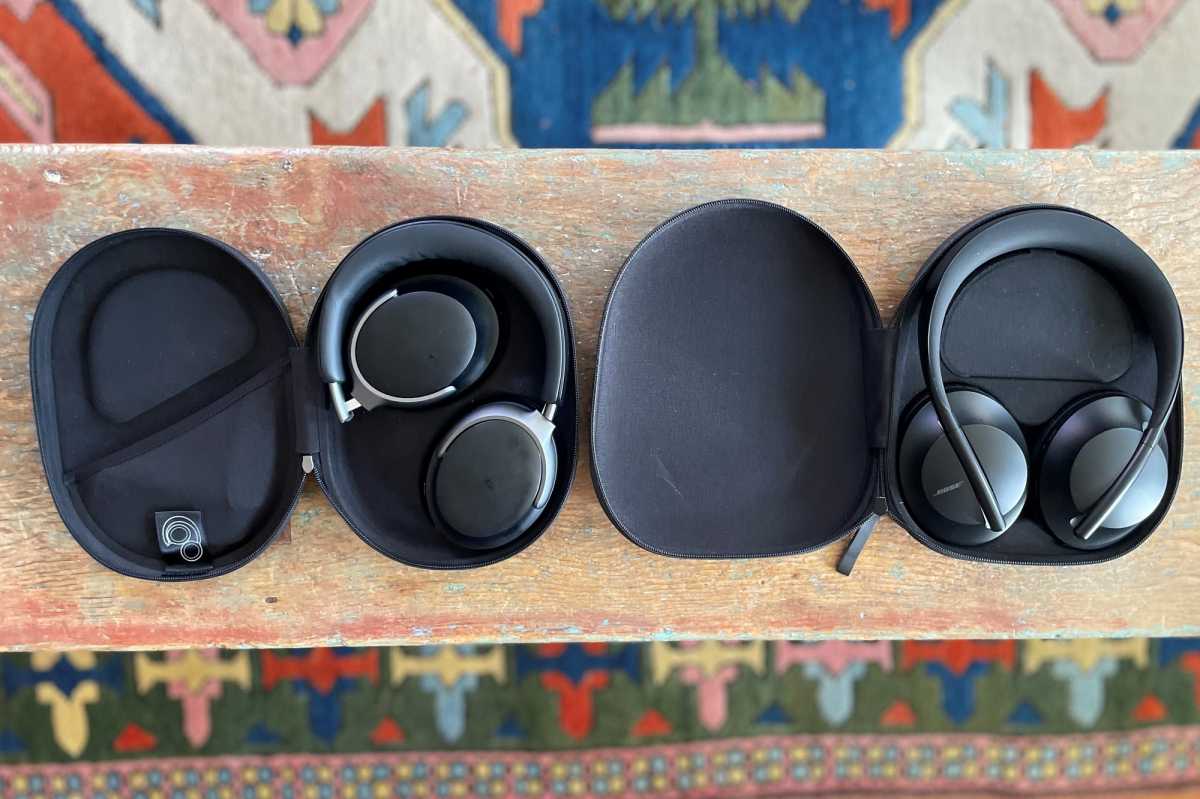
The Bose QuietComfort Ultra Headphones (left) replace the more radically styled Bose Headphones 700 at the top of the company’s over-ear lineup.
Jonathan Takiff/Foundry
Clamping pressure is firm enough to assure stability but not so harsh as to annoy. The soft-touch pleather and memory foam in the headband and ear cups feels premium grade and it seals and cushions reasonably without being bulky. These cans fold flat and rotate inward for packing in their relatively compact case. (The ear cups on the Headphones 700 don’t rotate.)
The headphones’ operational controls are minimalist, with no controls at all on the left-hand ear cup—just the USB-C port and headphone jack. On the right-hand cup, you’ll locate—by touch—just two buttons on the inner rim and a thin thermal volume strip on the curved outer rim.
This review is part of TechHive’s in-depth coverage of the best noise-cancelling headphones.
Advanced On-Head Detection circuitry on the Bose QC Ultra senses when you’ve put them on, so I haven’t had much use for the bottom-right button that handles power on/off and Bluetooth pairing. Wrap them around your ears and they’ll quickly power up and kickstart the music over your Bluetooth connection. Those sensors also work in reverse, stopping the music and shifting the headphones into a low-power standby mode when you pull them off.
After achieving a full charge in less than three hours, I left the headphones in standby mode overnight. When I put them back on my head 10 hours later, Bose’s app was still showing a 100-percent charge. The manufacturer says the cans will finally auto shut off after 24 hours of idle time (although that can be adjusted in settings). Run time is also quoted as 24 hours on a charge with Bose’s Immersive Audio circuitry turned off, or 18 hours with it on.

The Bose Quiet Comfort Ultra Headphones come with a hard-sided carrying case, a headphone cable, and a USB-C charging cable.
Jonathan Takiff/Foundry
The slightly raised touch strip on the right-hand ear cup is a little easier to use than the thermal panel found on the Bose Headphones 700, even if it’s not as versatile. Sliding a finger up or down the strip adjusts the volume. Tapping and holding the strip activates one of several shortcuts: You can hear the headphones’ battery level, change its Immersive Audio setting, wake your phone’s onboard voice assistant, or launch Spotify (that last one is a new trick in the QuietComfort bag). But only one of those shortcuts can be available at any one time (you choose in the Bose Music app).
A second button on the right-hand ear cup performs several functions: Short taps here play/pause the music, skip to the next or previous track, answer or decline a call, or put a call on hold to take another. A long press lets you cycle through audio listening modes. Three modes are already loaded—Quiet (full-strength noise cancelling), Aware (which allows in some outside sound), and Immersion (spatial processing with optimized ANC, but no headtracking.)
You can also create and store four more custom modes, to do things like adjust the ANC level (from 0 to 10) and initiate ActiveSense (auto noise cancellation that adjusts itself to the environment). I was particularly taken by the excellent performance of the Wind Noise Suppression feature and even more by the Aware option that opens the headphone’s mics for interaction with the outside world. On a visit to Philadelphia’s historic Italian Market, I easily negotiated with the vendors without removing the headset or pausing my music. The miking clarity and levels-balancing are superb.
Audio performance
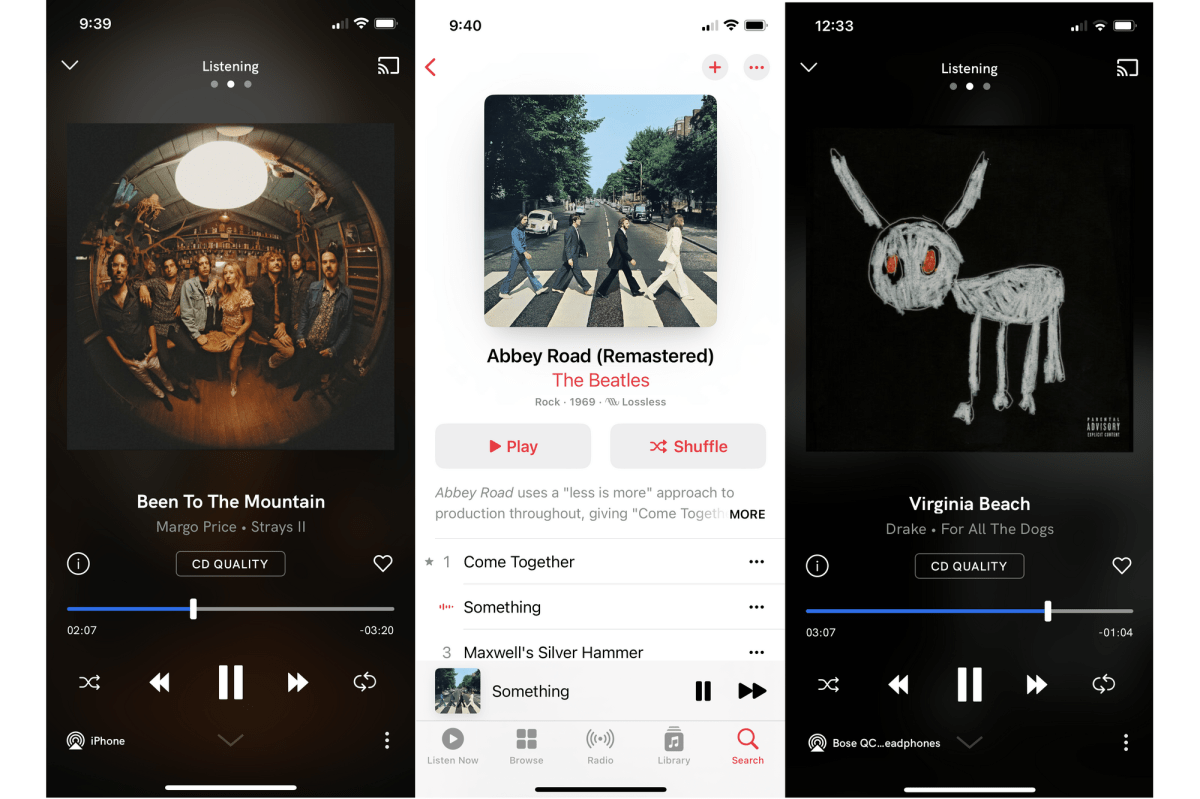
Audio recordings by Margo Price and Drake sounded bigger and bolder on the Bose QuietComfort Ultra Headphones, but a 2019 remastered Abbey Road actually sounded better on their new and less-expensive stablemate, the Bose QuietComfort Headphones. Go figure.
Jonathan Takiff/Foundry
With EQ settings flat and other sound-altering options off, I heard noticeably deeper bass excursion that added extra drama to new sets from Drake and twang-rocking Margo Price. And at the other end of the frequency spectrum, I was duly impressed by a nimble high end that kept its cool with even the peakiest vocals in my torture-test library.
Curiously, the QC Ultra use the same drivers as the Headphones 700, so how to explain the improvements? Bose engineers have long been masters of software-tweaking to ratchet up the performance of components.
And with both the QuietComfort Ultra headphones and the new QuietComfort Ultra Earbuds, Bose is introducing Immersive Audio, its homegrown take on spatial audio, which uses complex signal processing to create a bigger, bolder out-of-headphone (if not out-of-body) listening experience. I first heard and reviewed it some on the Bose QC Ultra Earbuds, but have since concluded that it works better with over-ear headphones than the in-ear type.
Immersive Audio performance
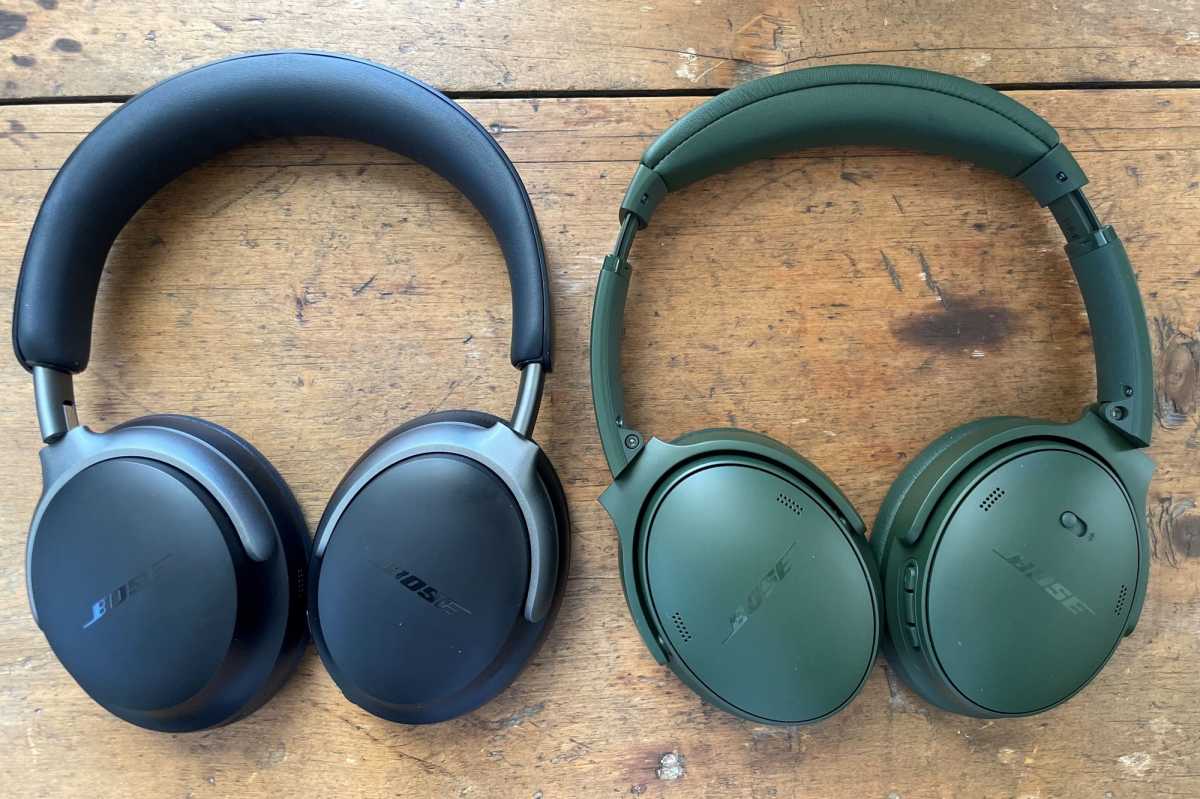
The Bose QuietComfort Ultra Headphones (left) look more posh than than their only slightly more plebian stablemate, the QuietComfort Headphones, and the latter can’t deliver Bose’s new Immersive Audio tech, either.
Jonathan Takiff/Foundry
If you find the vibes and presence of amplified live music more exciting than listening to discs and streams at home, you’ll want to activate Bose’s Immersive Audio on its QC Ultra Headphones and QC Ultra Earbuds frequently.
Audio purists, on the other hand, listeners who revel in the dry, intimate, unvarnished sound of music captured in a first-class recording studio (or symphony hall) with little or no signal processing and amplification applied will want to leave this feature turned off—or use it sparingly.
Serving the cause of extra vitality and added spaciousness, Bose’s Immersive Audio performs post-production processing tricks on the recordings you feed it. Bose isn’t sharing how its secret sauce is made, but it’s obvious they’re adding light echo and distortion effects to increase vocal oomph, while also working frequency-based signal isolation, time delay, and phase changes to put more air and distance between instruments.
Does it work? Yes. Does it work well? Sometimes.
For A/B comparisons, I let Apple Music pick the test material: a playlist of classic 1970s singer-songwriter fare methodically recorded (in the big-budget album era) in primo studios. As each track came up, I compared how the music sounded with Immersive Audio on, and then off; a switcheroo easily done in the Bose Music app.
On the bright side, I glommed good vibes with Immersive Audio applied to Billy Joel’s studio performance of “New York State of Mind” and Rickie Lee Jones’ “Lucky Guy.” The Bose processing freshened both sessions with a livelier, atmospheric jazz-nightclub vibe. Immersive Audio also lent a sharper edge to Ms. Jones’ often mush-mouth pronunciation.
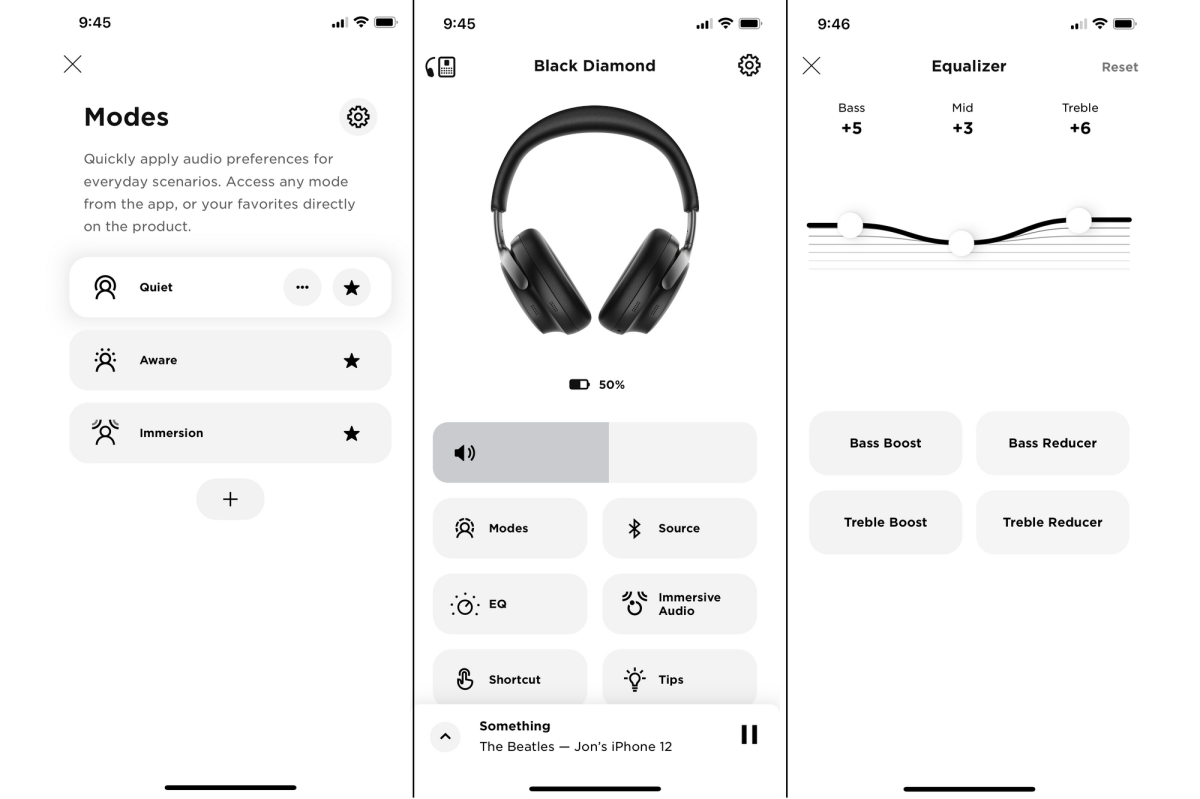
The Bose Music app provides many more control options than could ever be accomplished with physical buttons on the headphones themselves.
Jonathan Takiff/Foundry
Elton John’s “Goodbye Yellow Brick Road” sounded more glistening and magical with Immersive Audio engaged, especially after I also activated the gyroscope-powered head-tracking feature that can accompany it. Click “Still” and the music becomes fixed in space, sounding as though it’s floating in front of you, rather than being locked inside your cans. As you twist and bop your head, your perspective of the music shifts. It’s literally moving and grooving more because you’re now in on the act, helping the sound field to seem three-dimensional.
With more controllable and finite head tracking, the parlor trick worked more effectively for me on the QC Ultra Headphones than it did on the QC Ultra Earbuds, which also have Immersive Audio onboard.
On the downside, not every 1970s flashback goes better with Immersive Audio. With Van Morrison’s “Have I Told You Lately” and Fleetwood Mac’s “Little Eyes,” a doubling-up of the echo chamber effect (already present in the original recordings) gave me the shivers. It also made mess of James Taylor’s intimate, chamber folk classic “Fire and Rain.”
Should you try enhancing podcasts with Immersive Audio? Please, no. Spare yourself.
Immersive Audio on the QC Ultra Headphones and QC Ultra Earbuds also came up very short when I compared the songs processed with Immersive Audio to versions remixed with Dolby Atmos and streamed from Apple Music and Amazon Music Unlimited to a pair of Apple AirPod Pro 2 earbuds.
With Dolby Atmos—and its rival Sony 360 Reality—an audio engineer has deliberately placed audio events in a 360-degree sphere. Bose’s Immersive Audio makes an effort to guess what will sound best. In one apt compare-and-contrast, the lilting female voices flying around pop gospel choir master Kirk Franklin’s album Father’s Day, remastered in Dolby Atmos, sounds heavenly, while the gritty-voiced, Immersive Audio-enhanced version never leaves the ground.
Active noise cancellation performance
I went a little crazy testing the Bose QuietComfort Ultra Headphones’ active noise cancelling performance. Since I still have the less-expensive QuietComfort Headphones and the QuietComfort Ultra Earbuds I reviewed for TechHive earlier, I decided to compare all three.
I repeatedly put on one then another to hear how each would deal with the 85 decibels of imported “cabin noise” (thanks to Sleep Jar’s Airplane Sounds) I cranked on a Sonos ERA 100 (I played no music on the headphones during the tests).
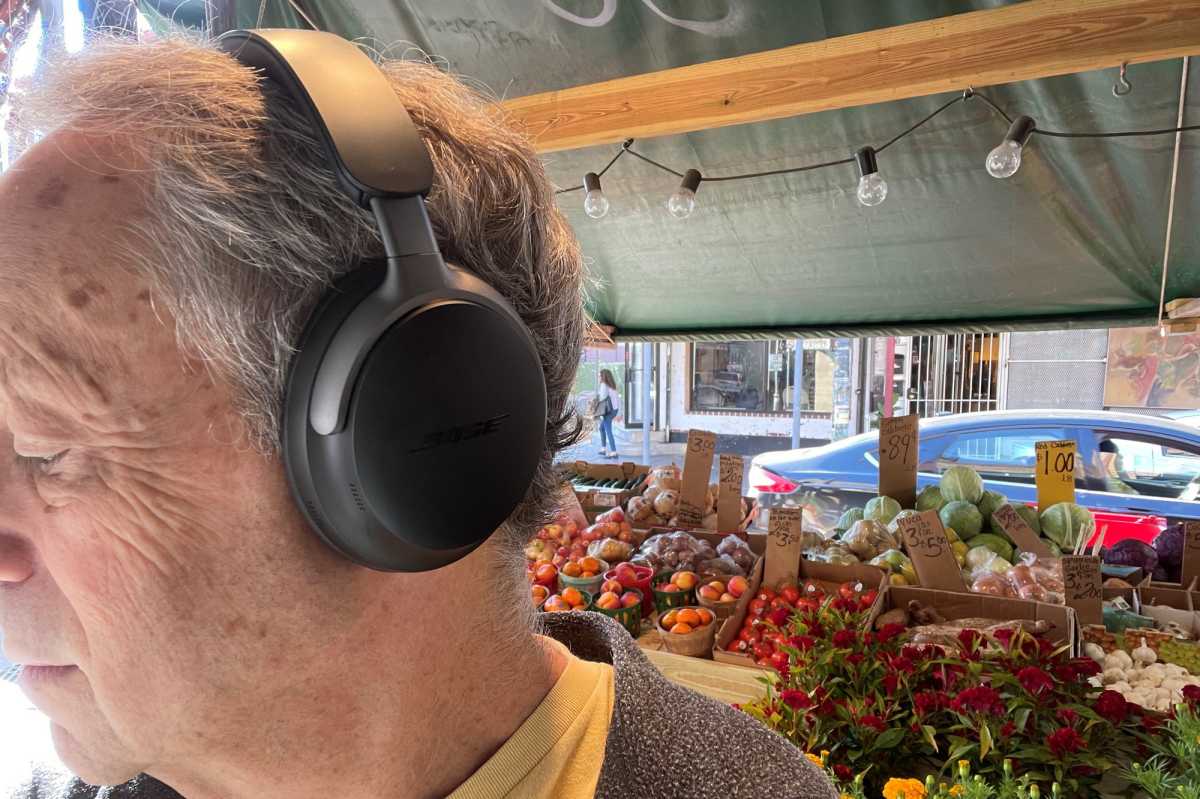
The Bose QuietComfort Ultra Headphones are comfortable for all-day listening, and they do a fabulous job of cancelling noise in all sorts of environments.
Jonathan Takiff/Foundry
Then, in a second stage of torture testing with that horrible noise still blasting and the headphones on, I’d repeatedly dial my home answering machine from my smartphone and murmur messages through the products’ directional beam-forming microphones, ostensibly designed to reject spurious noises.
The three pair placed good, better, best: The QC Ultra Earbuds did a damn good job of blocking the cabin noise from my tender ears, but they didn’t filter out much fake cabin din when I used their mics to make a phone call. With the QC Headphones working their ANC, the noxious noise floor dropped even further—reducing the blasting to a light jiggle sound in my head. Finally, the QC Ultra Headphones proved even more agile. The intrusive sound was now reduced to a mere wisp of wind.
Both over-ear models did well at masking the cabin noise—significantly better than the QC Ultra buds—during those calls to my answering machine, but the QC Ultra Headphone won this match by a whisker.
Curiously, I got different results while streaming another ambient noise collection at 75dB: “Noisy Restaurant.” The QC Ultra Buds did the best job of masking the sound of cluttering cups, garbled voices, and shuffling feet. But none did better than just OK at hiding those sounds when I called my own answering machine.
Should you buy the Bose QuietComfort Ultra Headphones?
The Bose QuietComfort Ultra Headphones nail it on most fronts: Audio performance, active noise cancellation, call quality, industrial design, and ergonomics.
Bose’s Immersive Audio enhances some music, but it’s ultimately more of a gimmick than a truly remarkable feature. And if you find you don’t like it, you can just leave it turned off. Bottom line: There’s more than enough here to make the Bose QuietComfort Ultra Headphones worth buying.

